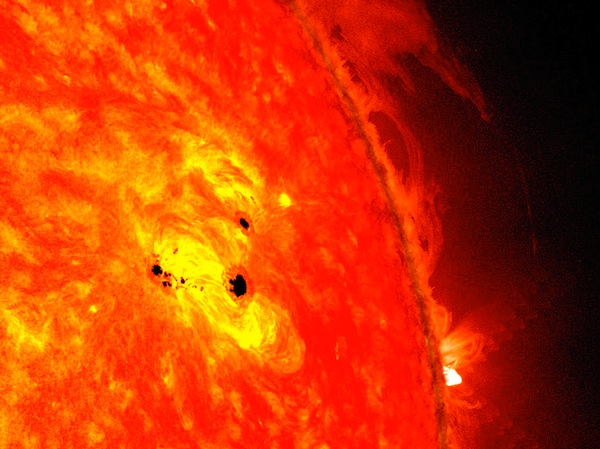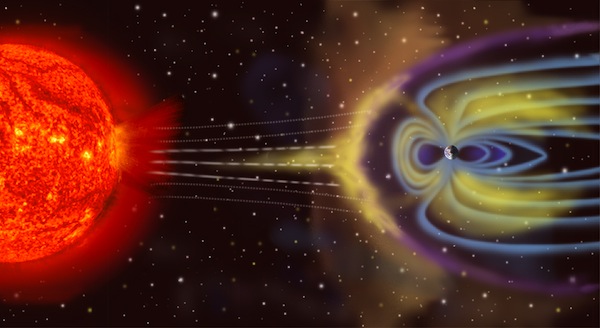What Damage Could Be Caused by a Massive Solar Storm?
An enormous solar storm could short out telecom satellites, radio communications, and power grids, leading to trillions of dollars in damages, experts say

A sunspot six times the diameter of Earth formed on the sun on Wednesday. Image via NASA/SDO/AIA/HMI/Goddard Space Flight Center
On Wednesday, NASA released an image of a series of enormous sunspots snapped by at the Solar Dynamics Observatory, an orbiting telescope. The sunspots—the dark spots in the center of the image—are estimated to be larger in diameter than six Earths placed next to each other.
These sunspots pose no inherent danger—they’re merely temporary areas of intense magnetic activity that inhibit the sun’s normal convection currents—but, on occasion, the unstable area around a sunspot can trigger an unusually large solar flare (below), flinging streams of radiation outward from the sun. And a big enough solar flare can lead to an alteration in solar wind significant enough to set off a geomagnetic storm here on Earth, with the potential to short the circuitry on satellites and disrupt our telecommunications infrastructure worldwide.
To be clear, such a scenario seems unlikely to occur from this current set of sunspots—SpaceWeather.com indicates there is just a 15% chance of X-class flares at the moment, the minimum level necessary to knock out satellites and ground-based communications technologies. But we decided to take this opportunity to imagine just how far-reaching the effects of a massive solar flare would be in today’s ultra-connected world.
It so happens that at least once during recorded history, a solar event of this magnitude did occur: the solar storm of 1859. On September 1 and 2 of that year, the largest geomagnetic storm in recorded history occurred, causing aurorae (the northern and southern lights) to be visible around the world. The Baltimore American and Commercial Advertiser wrote:
Those who happened to be out late on Thursday night had an opportunity of witnessing another magnificent display of the auroral lights…The light appeared to cover the whole firmament, apparently like a luminous cloud, through which the stars of the larger magnitude indistinctly shone. The light was greater than that of the moon at its full, but had an indescribable softness and delicacy that seemed to envelop everything upon which it rested.
Of course, the massive solar storm also caused damage, triggering telegraph malfunctions (even giving operators electrical shocks) and causing some telegraph pylons to suddenly spark and catch fire.
A much smaller solar storm occurred in 1989, knocking out power throughout much of Quebec for over 9 hours, disrupting communications with several satellites in orbit and interfering with the broadcast of short-wave radio in Russia. Aurorae were reportedly visible as far south as Florida and Georgia; given the ongoing Cold War and the fact that many had never seen this phenomenon before, some feared that a nuclear strike was in progress.
How did solar activity 93 million miles away lead to such destruction? These types of storms are the result of a sudden coronal mass ejection (CME)—a massive burst of solar plasma (electrons, protons, and ions) that is hurtled out into space—which often occurs alongside particularly large solar flares.
The solar wind is a continuous stream of charged particles thrown out from the sun towards earth, but a particularly large CME can lead to a big enough surge in the speed and energy of the particles to disrupt the magnetic field surrounding Earth. This, in turn, causes aurorae and the disruptions to our telecommunications equipment, which rely upon electromagnetic forces.

An artist’s rendering of the solar wind interacting with the Earth’s magnetic field. Image via NASA
If a CME as large as the one that triggered the 1859 storm were to occur today, the consequences could be devastating. Given the increase in our reliance on electricity and telecommunications (even since 1989), the effects would certainly be far more significant than malfunctioning telegraph pylons.
It’s hard to appreciate just how many aspects of modern life rely on technologies that could be affected. As Daniel Baker of the University of Colorado’s Laboratory for Atmospheric and Space Physics told National Geographic in 2011, ”Every time you purchase a gallon of gas with your credit card, that’s a satellite transaction.” A giant storm could disrupt our GPS systems, communication with planes in flight and other crucial satellite-based technologies.
But the biggest concern, experts say, would be disruptions to our power grid—as a 2011 OECD report (PDF) on the impacts of solar storms points out, “Electric power is modern society’s cornerstone technology on which virtually all other infrastructures and services depend.” A surge in solar wind can blow out power transformers by melting their copper windings, and especially in highly interconnected regions (such as the East Coast), transformer failures can trigger cascading effects, spreading power outages over wide areas.
One analysis looked at a 1921 storm—which was ten times more powerful than the 1989 event—and estimated that if it occurred today, it would leave some 130 million people without power, potentially affecting water and food distribution, heating and air conditioning, sewage disposal and a host of other aspects of the infrastructure we take for granted daily. The total cost of an even larger storm, such as the 1859 event, could be enormous: an estimated $1 to $2 trillion in the first year alone, and a total recovery that could take 4 to 10 years in total.
The good news is that CMEs large enough to trigger a disruptions like the 1859 storm are rare–for the most severe damage to occur, a CME has to be directed in such away that Earth receives the brunt of the blast. Fortunately, solar activity occurs in a cycle with a duration of roughly 11 years, during which all kinds of solar activity (including the number of sunspots, the frequency of flares and the level of mass ejections) fluctuate from high to low and back to high again. However, we’re near the peak of the cycle, which NASA predicts will occur this fall.
Both NASA and the National Weather Service’s Space Weather Prediction Center monitor solar activity and issue warnings when CMEs and other alterations in the solar wind occur. The SWPC’s current 3-day forecast predicts no storms over the weekend, despite this new enormous sunspot.
If a massive CME were spotted, such 3-day forecasts give us some lead time: there are some measures electric utilities could take to protect their equipment, such as quickly disconnecting transformers. Polar flights, which travel at the highest altitudes, could be rerouted to avoid contact with damaging solar particles, and some satellites could be switched into a safe mode to minimize damage. Here on Earth, at the very least, we’d have some time to prepare for potential power blackouts and other problems.
/https://tf-cmsv2-smithsonianmag-media.s3.amazonaws.com/accounts/headshot/joseph-stromberg-240.jpg)
/https://tf-cmsv2-smithsonianmag-media.s3.amazonaws.com/accounts/headshot/joseph-stromberg-240.jpg)